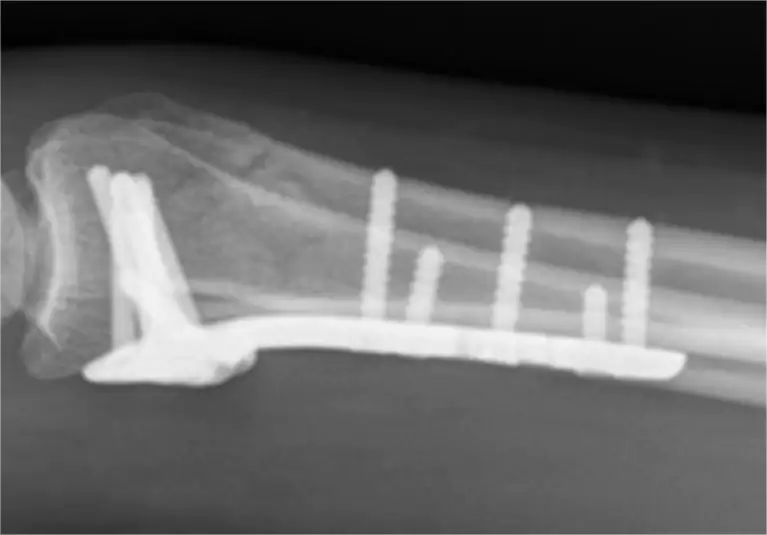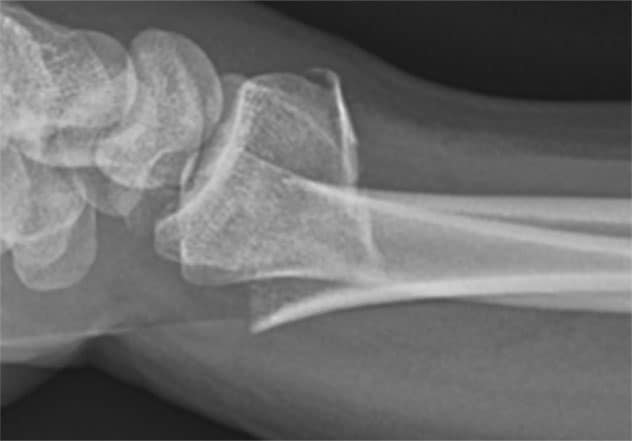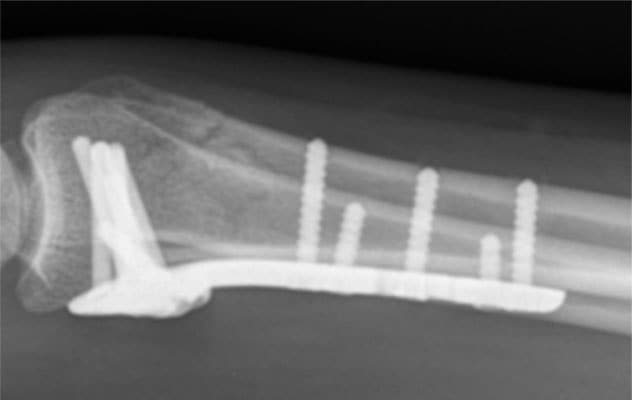
Mayo Clinic’s orthopedic surgeons have expertise in treating even the most complex distal radial fractures. As members of a fully integrated practice, the surgeons also collaborate with other specialists to manage the care of individuals with comorbidities that can increase the risks of wrist surgery.
At Mayo Clinic, state-of-the-art technology facilitates timely imaging of distal radial fractures. Cone-beam CT scans can be performed in the room where casts are applied. “That imaging allows us to very quickly look at any details of the injury, such as an articular fracture versus a simple transverse fracture,” Dr. Dennison says.
For complex fractures, treatment plans encompass the entire process of multidisciplinary care. “Before surgery we make sure that our anesthesiologists and our rehabilitation specialists are aware of our patients’ needs. We use a coordinated approach for fracture repair and recovery,” Dr. Dennison says.

Displaced fracture of distal radius
X-ray shows a displaced fracture of the distal radius.
Patients’ activity levels and desired wrist function are key factors in determining treatment. “We look closely at the extent of joint displacement to determine the odds of developing arthritis or difficulty with wrist rotation,” Dr. Dennison says. “Anatomical alignment is important for active individuals who want to resume certain activities. As people age and are less active, deformities are usually tolerated better. We might allow for less precise alignment for less active patients who are in their 70s and 80s.”

Plate and screws provide stability after open repair
X-ray taken after open repair of the fracture shows a plate and screws to provide stability until the bone is healed.
Patients referred for revision surgery constitute a large portion of Mayo Clinic’s distal radial fracture practice. “These patients may have had poor healing due to misalignment in the cast or a complication from the hardware,” Dr. Dennison says. “Although we are usually able to help these patients, it’s ideal to see patients at the time of fracture because fractures are usually easier to treat the first time.”
For some patients, postoperative rehabilitation with a hand therapist is an important aspect of care. “The key is identifying people who need therapy,” Dr. Dennison says. “With instruction, people who had straightforward surgeries or casts will achieve their desired range of motion very nicely on their own within 6 to 9 months of completing treatment. Therapy, though, often speeds up the recovery of function — especially for people who were in casts or surgical dressings for long periods of time — and can minimize problems with stiff hands and shoulders.”
Postoperative care might also include referrals to Endocrinology. “We like to maintain a close eye on bone health for patients who are at risk of more fractures,” Dr. Dennison says.
For all individuals with distal radial fractures, Mayo Clinic strives to restore the optimal desired wrist function. “Whether the fracture is part of an acute polytrauma or the result of a fall by an older person or a weekend warrior, we provide integrated care to get our patients up and going again,” Dr. Dennison says.
Post time: Apr-04-2023







